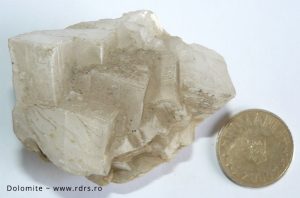The Dolomite Raman spectrum and its interpretation are presented below.
Dolomite sample data
| Description: | Dolomite mineral sample |
|---|---|
| Mineral: | Dolomite |
| RAMAN ID: | RAMAN5451 |
| Ideal chemistry: | CaMg(CO3)2 |
| Source: | Grigore Cobălcescu Museum |
| Locality: | Fiesch – Switzerland |
| Owner: | Department of Geology – Alexandru Ioan Cuza University of Iasi |
Dolomite sample image

Main Raman bands of Dolomite
| Wavenumbers (cm-1): | 1087vs, 714w, 285m |
|---|
Raman parameters
| Instrument settings: | Raman spectrograph HE 532nm (Horiba Jobin-Yvon) |
|---|---|
| Spectral resolution: | 2 cm-1 |
| Conditions of measurement: | at room temperature |
Interpretation of Raman spectrum of Dolomite
In this study only ν1 (1087 cm-1), ν4 (714 cm-1) bands are observed in the Raman spectrum, ν2 and ν3 modes are absent. The external vibration mode observed at 285 cm-1 are due to the relative translations between the cation and anionic groups (Gunasekaran, 2006).
| Buzgar and Apopei, 2009 | Gunasekaran et al., 2006 | Assignment |
| 187 | T(Ca, Mg, CO3) | |
| 285 | 309 | T(Ca, Mg, CO3) |
| 714 | 733 | ν4 symmetric CO3 deformation |
| ν2 asymmetric CO3 deformation | ||
| 1087 | 1106 | ν1 symmetric CO3 stretching |
| NO | 1450 | ν3 asymmetric CO3 stretching |
| NO | 1765 | ν1 + v4 |
NO = not observed
The difference in site symmetries for dolomite and calcite results from substitution of Mg atom for one of the two Ca atoms for about each molecular oxygen atom. Thus the IR and Raman spectra of dolomite resemble those of calcite. In literature, Gunasekaran et al. (2006) have reported bands for the ν3 vibrational modes of CO3 group (1450, respectively 1445 cm-1), values that in this study were not observed. Gunasekaran et al. (2006) have also reported a Raman band at 1765 cm-1 assigned to ν1 + ν4 combination.
References for the Raman spectrum of Dolomite
- BUZGAR N., APOPEI A. I. (2009) – The Raman study on certain carbonates. Analele Stiintifice ale Universitatii “Al. I. Cuza” – Iasi, Tome 55, issue 2, 97-112 [link]
- GUNASEKARAN S., ANBALAGAN G., PANDI S. (2006) – Raman and infrared spectra of carbonates of calcite structure. Journal of Raman Spectroscopy, 37, p. 892-899 [link]
